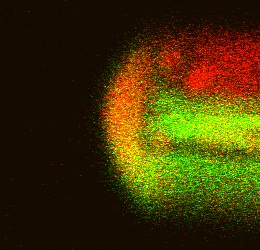I’VE BEEN following developments in microfluidics for a couple of decades now, since I first got my hands on a prototype glass chip in a German development laboratory in the 1990s.
After asking my hosts very nicely, they reluctantly opened the secure case where the postage-stamp sized microfluidic circuit was displayed, and allowed me to hold it with a gloved hand in order to better appreciate its tiny engineering.
As I recall, it had four fluid channels and two reaction vessels enclosed within a near-transparent sliver of glass. I also recall the horror on the faces of the hosts when I pulled out my camera (a good old-fashioned 35mm device) and attempted to take a picture of the thing. I was quickly relieved of the microfluidic chip and ushered out of the laboratory.
In the years since, I have sometimes wondered why the promised microfluidic revolution has not really happened. We see the technology on a daily basis in inkjet printers, and microfluidic chips are now found in specialised applications the laboratory, but it hasn’t really changed the world.
Since then developments have predictably gone down-scale, and nanofluidics seems to be the cutting edge today. So I was surprised to learn of a development which goes not one but two scales smaller, leapfrogging picofluidics to enter the femto realm.
In what is billed as the world’s smallest reaction vessel, scientists from New Zealand, Austria and the UK have mixed fluid volumes measured in femtolitres. This is so small that it could enable chemical reactions to take place inside individual cells.
The lead researcher is Peter Derrick, professor of chemical physics and physical chemistry and head of the Institute of Fundamental Sciences at Massey University in New Zealand, who has an impressively long job title considering how small are the volumes he works with.

Confocal micrograph showing the two streams of liquids and the fused Taylor cone
The reaction ‘chamber’ is produced by electrospray ionisation, which naturally forms cones of ionised fluid called Taylor cones. The technique is just like that used for sample preparation before mass spectrometry.
By placing two very small nozzles in close proximity, the chemicals sprayed from each are forced into contact to create incredibly fast reactions on the tiniest of scales. The researchers reckon the reaction between the antibiotic vancyomycin and a peptide took just a few tens of microseconds in their experiments.
The work appears in the latest issue of the European Journal of Mass Spectrometry (Eur. J. Mass Spectrom. 18(5), 439–446 (2012), doi: 10.1255/ejms.1198)
Somehow I doubt that we’ll see femtofluidics in any real life applications in the near future, but I do hope this technology contributes more than just making inkjet images a bit sharper.
I hope you find the LabHomepage website, and this weekly newsletter, useful. Comments and feedback are always welcome: news@labhomepage.com Please help us build our circulation base by forwarding this to any friends that might like it, and suggest they subscribe at http://eepurl.com/itOV2
best wishes
Russ Swan
editor, LabHomepage.com
THIS WEEK’STOP STORIES
1. Microscope claims new standard for luminescent live cell imaging
NORTH American researchers can now get their hands on the Olympus LV200 benchtop microscope, which has already been available to those in Europe and Japan. The LV200 is designed to…
2. Clinical chemistry analyser includes clot detection
THE NEW RX Daytona Plus clinical chemistry analyser from Randox is said to be the only analyser in its class to include a sample clot detection sensor. This mid-range instrument offers…
http://labhomepage.com/3405/diagnostic/clinical-chemistry-analyser-includes-clot-detection/
3. Combined CGH and SNP analysis makes for faster research
COMPARATIVE genomic hybridisation plus single nucleotide polymorphism microarray analysis is now being offered by Wicell, a non-profit organisation and leading distributor of…
http://labhomepage.com/3401/genomics/combined-cgh-and-snp-analysis-makes-for-faster-research/
4. Take control of CO2 mixtures during live cell imaging
THE OKOLAB Bold Line CO2 controller, available in the USA from distributor Warner Instruments, give the scientist full control of atmospheric gas concentrations during imaging work on live…
http://labhomepage.com/3367/imaging/take-control-of-co2-mixtures-during-live-cell-imaging/
5. More storage volume in 96-tube format
STORING high sample volumes in the minimum space is a challenge faced by many laboratories. Micronic now offers a new answer to this perennial dilemma with its 2.00ml storage tubes…
http://labhomepage.com/3413/labware/more-storage-volume-in-96-tube-format/
6. Nanoscale thermal analysis to improve drug delivery
AT THE University of East Anglia, UK , post-doctoral researcher Jonathan Moffat is studying the delivery of drugs with poor water solubility, and looking in particular at the characterisation of…
http://labhomepage.com/3390/drug-development/nanoscale-thermal-analysis-to-improve-drug-delivery/
7. Qualified human feeder cells for iPSC reprogramming
A NEW range of human feeder cells from Amsbio are qualified for induced Pluripotent Stem Cell (iPSC) reprogramming. These newborn human foreskin fibroblasts, available under…
http://labhomepage.com/3359/stem-cell/qualified-human-feeder-cells-for-ipsc-reprogramming/
8. Closed-tube shredder gives better biological samples
IMPROVED sample preparation is promised by the new PBI Shredder SG3 from Cole-Parmer, a closed system device said to be ideal for molecular and cellular biological analysis. Intended for…
http://labhomepage.com/3320/sample-preparation/closed-tube-shredder-gives-better-biological-samples/
9. A centrifuge for all laboratory applications
MEDLINE Scientific reckons its new range of compact bench-top centrifuges includes models to cover almost all operations in life-science laboratories, including biochemistry, chemistry…
http://labhomepage.com/3380/centrifuge/a-centrifuge-for-all-laboratory-applications/
10. Predicting the effect of particle size in heterogeneous catalyst development
MALVERN Instruments has published a new application note which discusses the importance of particle size in heterogeneous catalyst materials, concluding that the company’s Mastersizer…
